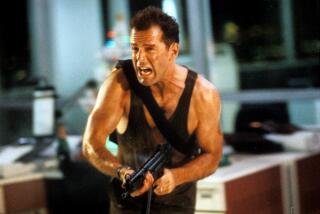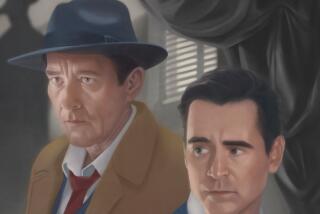Welles Gives His Film Noir Just the Right Touch of ‘Evil’
- Share via
If you’ve never seen “Touch of Evil,” be ready for a jolt. The Orson Welles that many remember, the baby-faced, youthful fellow from “Citizen Kane” is no more.
In the 1958 movie (17 years after “Citizen Kane”), Welles has settled into his fat era. Like Elvis, he’s let himself expand and expand, but Welles uses the bulk perfectly in “Touch of Evil,” which screens Friday night at the Newport Harbor Art Museum in a retrospective of the filmmaker’s career.
As Hank Quinlan, the creepy cop at the dingy center of “Touch of Evil,” Welles looks ready to explode with venom. He’s a huge, sweaty balloon primed to pop, filling the movie with stinking air. In short, he’s great, the ideal creation for a superbly vile example of film noir.
The picture, which shocked most audiences because of its trashy plot and gutter stylizations when first released, has since become a cult darling. Some say that, in its own shameless way, “Touch of Evil” is as impressive as “Citizen Kane.” That’s a crazy reach, but it is captivating, and remarkably effective at creating a mood of pervading corruption. Besides, “Touch of Evil” is one of the most amusing movies Welles ever made.
Many of his cinematic impulses here are striking, both for their audacity and humor. The dialogue Welles wrote for Quinlan is all spit and spite; he’s unnerving, but you laugh because he’s so comfortable with being a sleaze.
Then there’s what Welles has done to poor Charlton Heston. This stalwart matinee idol still plays the hero, Vargas, a good detective from Mexico, but Welles inflicts dark face makeup, a black hair-dye job and a gigolo’s worm-thin mustache on him.
For more fun, we have Janet Leigh playing Heston’s bombshell of a wife, Susie. She’s spunky in her bosom-gripping sweaters, talking back to the bad guys up to the moment she’s drugged and lying naked on a “reefer” strewn bed in a rancid hotel room as part of a frame-up by Quinlan. Also, take a long look at Dennis Weaver as a rattled motel manager; he was doing gonzo Dennis Hopper way before Dennis Hopper.
But before all that, Quinlan and Vargas begin their faceoff in the border town of Los Robles (which is actually Los Angeles’ Venice, filmed during much seedier days). Vargas witnesses a car bombing murder while walking with Susie and decides to investigate on his own, a move that riles Quinlan, who’s handling the case on the U.S. side and doesn’t like interference from anyone who “speaks Mexican.” By the time Vargas discovers that Quinlan has a habit of planting evidence on suspected criminals, the two are hardened enemies.
The film is more expressionistic and crude than “The Lady From Shanghai,” Welles’ 1948 film noir that screened at the museum last week. Welles keeps everything purposely rough--most scenes are at night, lit only by gaudy street lamps, and he uses hip-hopping, nightmarish camera angles and rabid music (lots of bongos) for atmosphere. The whole movie looks decayed, and that suits the pulp story line.
It’s actually remarkable that Welles was able to make the picture in the first place.
Labeled a maverick troublemaker, Welles had been pushed out of Hollywood in the late ‘40s and early ‘50s and was given the “Touch of Evil” job by Universal after nearly a decade away from America. Studio bosses reasoned that if he was willing to do a budget-minded B-movie, they were willing to take a chance on him.
Faced with money constraints, he let his individualist’s instincts take over. He also got a little help from his friends; both Joseph Cotten, one of the stars of “Citizen Kane” and “The Magnificent Ambersons,” and Marlene Dietrich, a longtime pal, took bit parts in “Touch of Evil” to give it a dose of star power.
*
What: Orson Welles’ “Touch of Evil.” When: Friday, Feb. 25, at 6:30 p.m. Where: Newport Harbor Art Museum, 850 San Clemente Drive, Newport Beach. Whereabouts: Take Pacific Coast Highway to Jamboree Road and head north to Santa Barbara Drive. Take a right to San Clemente Drive and then a left. Wherewithal: $3 for museum members, seniors and students; $5 for the public. Where to call: (714) 759-1122.
More to Read
The biggest entertainment stories
Get our big stories about Hollywood, film, television, music, arts, culture and more right in your inbox as soon as they publish.
You may occasionally receive promotional content from the Los Angeles Times.










